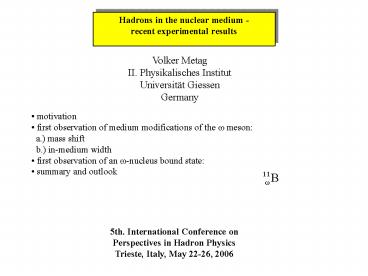PowerPoint-Pr - PowerPoint PPT Presentation
1 / 25
Title: PowerPoint-Pr
1
Hadrons in the nuclear medium - recent
experimental results
Volker Metag II. Physikalisches
Institut Universität Giessen Germany
5th. International Conference on Perspectives in
Hadron Physics Trieste, Italy, May 22-26, 2006
2
Motivation
- QCD-vacuum complicated structure
- characterized by condensates
- in the nuclear medium
- condensates are changed
- change of the hadronic excitation
- energy spectrum
- widespread experimental activities to search for
- in-medium modifications of hadrons
3
model predictions for in-medium masses of mesons
4
Model predictions for spectral functions of r and
w mesons
5
Model predictions for spectral functions of r and
w mesons
6
experimental approach dilepton spectroscopy r,
w, f ? ee-
essential advantage no final state interactions
!!
- CLAS (Jlab) C. Tur et al., ?A ??, ?, ? X
- HADES (GSI) planned experiment ?- p ? ? n on
bound proton
7
?-mass in nuclei from photonuclear reactions
advantage p0g large branching ratio (8 )
no ?-contribution (? ? ?0? 7 ? 10-4)
disadvantage p0-rescattering
8
Expected ? in-medium signal
rescattering of pions in nuclei predominantly
proceeds through ?(1232) excitation scattered
pions have Ekin?150 MeV
no distortion by pion rescattering expected in
mass range of interest
9
(No Transcript)
10
comparison of meson masses and lineshapes for LH2
and nuclear targets
?0
?
??
No change of mass and lineshape for longlived
mesons (?0, ?, ??) decaying outside nuclei
11
inclusive ???0? signal for LH2 and Nb target
D. Trnka et al., PRL 94 (2005)192303
difference in line shape of ? signal for proton
and nuclear target
12
decomposition of ? signal into in-medium and
vacuum decay contributions
Nb in-medium 45
C in-medium 40
lineshape of vacuum contribution taken from LH2
experiment
shape of in-medium contribution taken from BUU
simulation (P. Mühlich and U. Mosel, NPA
(2006)), assuming m? m0(1 - 0.16 ?/?0)
13
access to in-medium ? width
in-medium ? width proportional to ? absorption ?
? ?v?abs
14
access to in-medium ? width
in-medium ? width proportional to ? absorption ?
? ?v?abs
normalization to C!!
transparency ratio
? 19 MeV
? 34 MeV
37 MeV
94 MeV
74 MeV
Comparison to data (D.Trnka et al.) ?(?0) ? 45
95 MeV
15
momentum dependence of ? signal (Nb-target)
- mass modification only for p?? 0.5 GeV/c
determination of momentum dependence of ? -
nucleus potential requires finer momentum bins
? improved 2nd. generation experiment
16
?-, ?-meson-nucleus potential
K. Saito, K. Tsushima, A.W. Thomas, hep-ph/0506314
predictions within the quark meson coupling model
(QMC)
? E(1s) -39 MeV ? 29 MeV ? E(1s) -100
MeV ? 31 MeV
? E(1s) -56 MeV ? 33 MeV ? E(1s) -118
MeV ? 33 MeV
17
(No Transcript)
18
(No Transcript)
19
correlation between ? momentum and proton angle
20
comparison of data on LH2 and C
21
(No Transcript)
22
Summary and outlook
major step forward towards understanding the
origin of hadron masses
- first evidence for ? mesic 11B
- remaining open questions
- ? momentum dependence of ?-nucleus potential?
- ? structure in ? strength function?
- ? confirm existence of ? mesic states in
heavier nuclei
- higher statistics needed !!
- improved experiments planned at MAMI and ELSA
23
CBELSA/TAPS collaboration
24
(No Transcript)
25
(No Transcript)






























